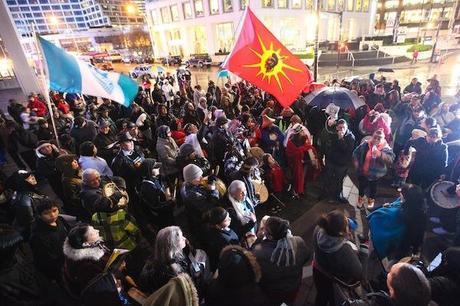
by Martha Troian / Indian Country Today
This time last year, flash mobs were erupting in shopping malls across Turtle Island as the movement known as Idle No More burst onto the international stage.
It was a season like no other, with a storm of flash mob round dances, thousands of Idle No More supporters braving a winter blizzard to protest on the steps of Parliament, and highway and rail shutdowns. There was Chief Theresa Spence of Attawapiskat, a small First Nation community located in northern Ontario, swathed in a blanket, standing outside a teepee at Victoria Island in Ottawa as her 44-day fast kicked into its second week.
Idle No More initially started as part of a teach-in event in Saskatoon when four indigenous women decided to address the federal government’s omnibus bill—a bill many felt would weaken Canada’s environmental laws and First Nation land rights. Neither blockades nor disruptions were part of the Idle No More’s founders’ intent, but the movement took on a life of its own, and nothing was going to stop it.
According to Idle No More’s website, co-founder Jessica Gordon from Pasqua Treaty 4 territory (Saskatchewan) referenced the first Idle No More tweet in late October. Thousands of tweets later, the hashtag can still be seen, along with an active Facebook page.
The Idle No More founders were recently named by Foreign Policy magazine as among the top 100 global thinkers of 2013. Idle No More has been regarded as one of the largest indigenous movements in recent history. For many, it has had a tremendous impact. But some say it wasn’t until Chief Spence began her protest fast that the movement really gained momentum.
“There is now a generation of children and youth that have seeds planted in their minds of the winter they danced in malls and intersections with their parents and families,” said Leanne Simpson, an Indigenous writer and academic of Mississauga Nishnaabeg ancestry. “Idle motivated people that hadn’t been politically active before to take a stand. It educated Canadians. It mobilized our allies.”
The movement not only raised morale among First Nations and other Indigenous Peoples of Canada but also heightened their profile on the national stage, said Pamela Palmater, a Mi’kmaq lawyer from Eel River Bar First Nation, and a vocal supporter of the movement.
“We saw elected and traditional leaders working together with their citizens and a coming together of Canadians and First Nations in ways never before seen,” said Palmater. “It also helped educate the media about our issues.”
And the government of Canada followed it every step of the way. Through Access-to-Information requests, various news outlets reported that this country’s spy agency, the Canadian Security Intelligence Service (CSIS), was monitoring the movement’s activities. The federal department of Aboriginal Affairs was closely following the Twitter hashtag.
Despite uniting and mobilizing people, Idle No More fell short, according to Hayden King, director of the Centre for Indigenous Governance at Ryerson University and a member of the Beausoleil First Nation.
“While it certainly raised awareness, promoted relationship-building and educated, many, many Canadians, it didn’t stop legislation, and we have an even more hostile government than before Idle No More emerged,” said King.
Since the advent of Idle No More, the government has passed even more contentious legislation, including the First Nations Financial Transparency Act, the First Nations Education Act and the Family Homes of Reserve Matrimonial Interests of Rights Act—to name a few—despite heavy opposition by First Nation leaders and communities.
Over the course of the year, we have also seen the government withholding residential school documents from the Truth and Reconciliation Commission, denying a national inquiry into the issue of missing and murdered indigenous women, and most recently, forcing a standoff with Elsipogtog First Nation over shale gas exploration.
Even though the government has said it is committed to “high-level dialogue” with indigenous people, as revealed in the Prime Minister’s notes on January 11, 2013, between a meeting with First Nation leaders, many find it hard to believe. The federal government continues to fight First Nation issues, particularly in the courts. In addition, many indigenous people were offended by this year’s Throne Speech, in which the government boasted that early settlers forged a country “where none would have otherwise existed.”
In his October visit to Canada, United Nations Special Rapporteur on the Rights of Indigenous Peoples James Anaya urged the government to improve its relationship with indigenous people in order to avoid a “rocky road” ahead. Many indigenous groups are now dealing with things on their own terms and building on the successes of Idle No More. For instance, initiatives such as Summer Sovereignty, and a recent National Day of Action, although they lagged in comparison to Idle No More, showed that the spirit and message of the movement is alive.
“Indigenous Peoples have been engaged in the project of resistance for over four centuries,” said Simpson, the writer. “Like any social movement it will continue to change and morph into something meaningful to our peoples.”
Simpson referred to the recent launch of Indigenous Nationhood Movement as an example of an alternative movement that is dedicated to nationhood, resurgence and decolonization.
“There is also a creative and cultural renaissance occurring, with people writing songs, blogs, articles, books, making films and other art, using new media,” said Jamaias DaCosta, an Idle No More organizer in Toronto, of mixed ancestry. “All of these things that are critical to indigenous nationhood and sovereignty, continue on the ground.”
But what is being formed from these movements, DaCosta said, is a new relationship between Indigenous Peoples and Canadians. Indigenous people are leading the way when it comes to safeguarding the environment, and many Canadians are right behind them, according to DaCosta. The standoff at Elsipogtog First Nation was a vivid example of this new dynamic.
“First Nations represent Canadians’ last best hope at protecting the lands and waters for all our future generations,” said Palmater.

